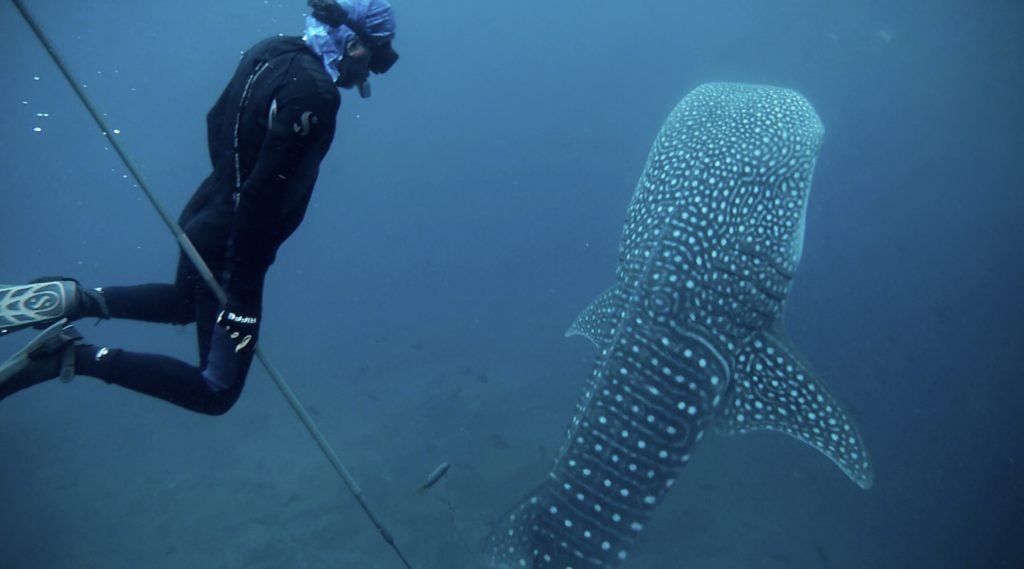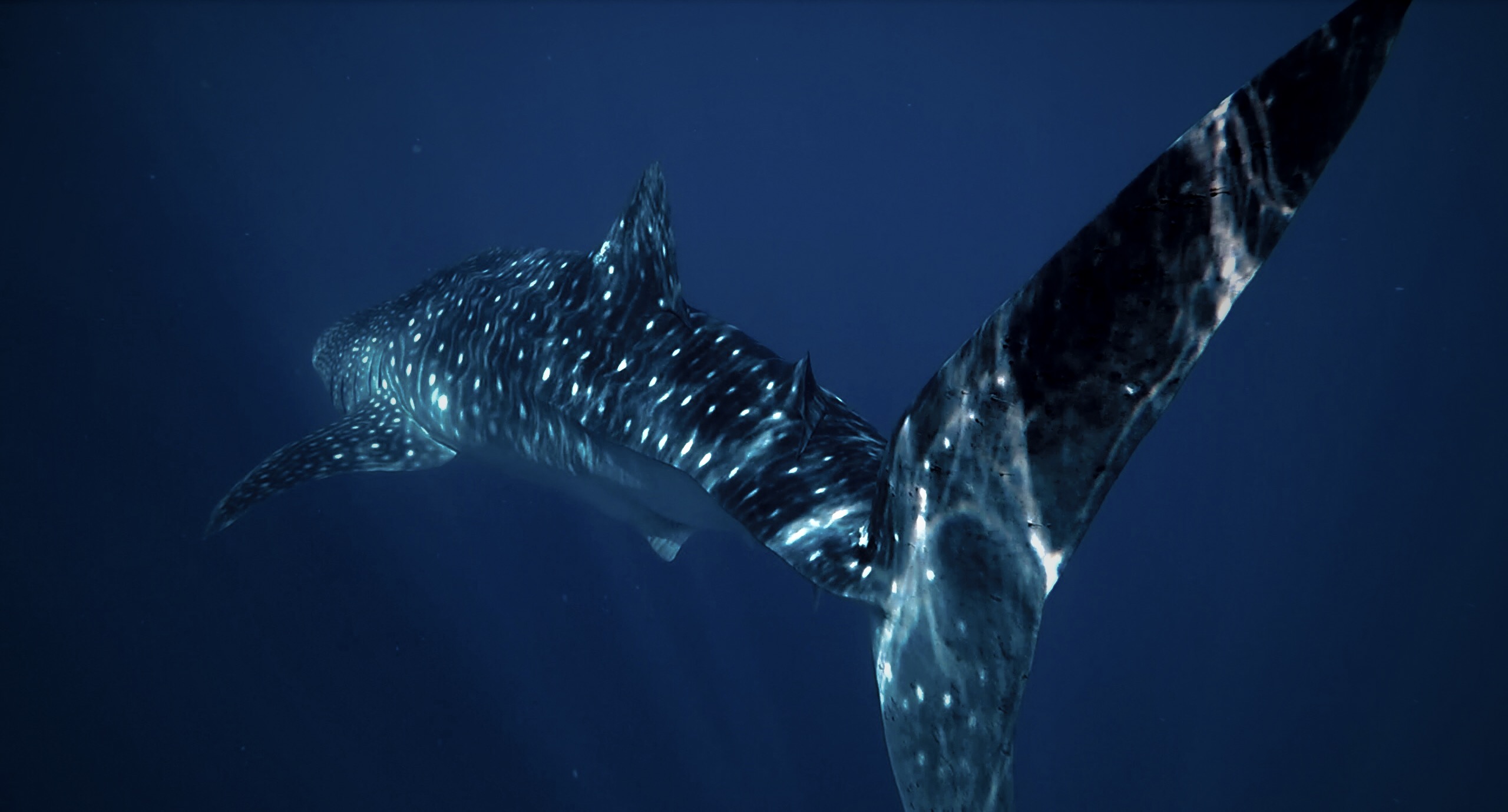Ancestors of Whale Sharks in Panama May Come from Distant Waters
November 18, 2021
Genetic population connectivity study of the endangered whale shark in Pacific Panama provides important data for conservation efforts.
By Leila Nilipour, photos by Candy K. Real
Spanish translation below.
The world’s largest fish, the whale shark (Rhincodon typus), is a plankton-loving giant that can be found alone or in groups in all tropical oceans. However, despite being a highly migratory species, little is known about how the different populations worldwide interact with each other. This lack of knowledge hinders conservation efforts aimed at protecting this endangered animal. Héctor Guzmán, a marine biologist at the Smithsonian Tropical Research Institute, alongside Caitlin Beaver of the US Geological Survey and Edgardo Díaz-Ferguson of Coiba Scientific Station, set out to start bridging this knowledge gap.
By snorkeling around Coiba National Park and in the Gulf of Chiriquí, in Pacific Panama, Guzmán collected tissue samples from 21 solitary sharks. The team conducted genetic analyzes on them and found out that they were highly diverse, with similarities to populations of whale sharks found in the Arabian Gulf, Western Indian Ocean, Mexico, and the Gulf of California. These results, which were published in Frontiers in Marine Science, suggest that whale sharks can travel over long distances and that transboundary conservation measures such as marine corridors may be effective for species conservation.

“Imagine Qatar: a possible journey of more than 27,000 kilometers from Panama for this species,” said Guzman. “This observed connectivity amazed us, revealing a real political challenge for the protection and conservation of whale sharks. It seems no longer a local or regional concern, but a global issue.”
Despite its small sample size, this study serves as a baseline for understanding the genetic diversity and population connectivity of this species, whose numbers have declined by half over the last forty years according to the International Union for the Conservation of Nature (IUCN). This type of data is necessary for deciphering the migration patterns of whale sharks, which are difficult to observe directly over the long term.

“With this publication we contribute to unravel migration and genetic connectivity patterns of transient whale sharks, evidencing the importance of Pacific Panama as a key area for connectivity of the species,” said Diaz- Ferguson.
This research was partially funded by the MarViva Foundation (Panama), the International Community Foundation-CANDEO, the Secretaria Nacional de Ciencia, Tecnología e Innovación de Panamá, and the Research Opportunity Fund of the Smithsonian Tropical Research Institute.
The Smithsonian Tropical Research Institute, headquartered in Panama City, Panama, is part of the Smithsonian Institution. The institute furthers the understanding of tropical nature and its importance to human welfare, trains students to conduct research in the tropics, and promotes conservation by increasing public awareness of the beauty and importance of tropical ecosystems.
Reference: Guzmán, H.M., Beaver, C.E., Díaz-Ferguson, (2021). Novel Insights Into the Genetic Population Connectivity of Transient Whale Sharks (Rhincodon typus) in Pacific Panama Provide Crucial Data for Conservation Efforts. Frontiers in Marine Science. https://doi.org/10.3389/fmars.2021.744109
Los ancestros de los tiburones ballena en Panamá podrían provenir de aguas lejanas
El pez más grande del mundo, el tiburón ballena (Rhincodon typus), es un gigante amante del plancton que se encuentra en todos los océanos tropicales. A pesar de ser una especie altamente migratoria, poco se sabe sobre cómo interactúan entre sí las distintas poblaciones alrededor del mundo, lo que dificulta los esfuerzos para la conservación de este animal en peligro de extinción. Héctor Guzmán, biólogo marino del Instituto Smithsonian de Investigaciones Tropicales, junto con Caitlin Beaver del Servicio Geológico de los Estados Unidos y Edgardo Díaz-Ferguson de la Estación Científica Coiba, se propusieron encontrar respuestas.
Buceando alrededor del Parque Nacional Coiba y en el Golfo de Chiriquí, en el Pacífico de Panamá, Guzmán recolectó muestras de tejido de 21 tiburones ballena. Les realizaron análisis genéticos y descubrieron que eran muy diversos, con similitudes a las poblaciones de tiburones ballena que se encuentran en el Golfo Arábigo, el Océano Índico Occidental, México y el Golfo de California.
Estos resultados, publicados en Frontiers in Marine Science, sugieren que los tiburones ballena pueden viajar largas distancias y que las medidas de conservación transfronterizas, como los corredores marinos, pueden ser efectivas para la conservación de la especie.
“Imagínese Qatar: un posible viaje de más de 27,000 kilómetros desde Panamá para esta especie”, comentó Guzmán. “Esta conectividad observada nos asombró y revela un verdadero desafío político para la protección y conservación de los tiburones ballena. Ya no es solo una preocupación local o regional, sino global”.
A pesar de que la muestra es pequeña, este estudio sirve como base para comprender la diversidad genética y la conectividad poblacional de esta especie, cuyas poblaciones se han reducido a la mitad en los últimos cuarenta años según la Unión Internacional para la Conservación de la Naturaleza (UICN). Este tipo de datos son necesarios para descifrar los patrones de migración de los tiburones ballena, animales que son difíciles de observar directamente a largo plazo.
“Con esta publicación contribuimos a desentrañar los patrones de migración y conectividad genética de los tiburones ballena, evidenciando la importancia del Pacífico de Panamá como un área clave para la conectividad de la especie”, comentó Díaz-Ferguson.
Esta investigación fue parcialmente financiada por la Fundación MarViva (Panamá), la International Community Foundation-CANDEO, la Secretaría Nacional de Ciencia, Tecnología e Innovación de Panamá, y el Research Opportunity Fund del Instituto Smithsonian de Investigaciones Tropicales.
The Smithsonian Tropical Research Institute, in Panama City, Panama, is a unit of the Smithsonian Institution. The Institute promotes an understanding of tropical nature and its importance to the well-being of humanity, trains students to conduct research in the tropics, and encourages conservation by raising public awareness of the beauty and importance of tropical ecosystems.








